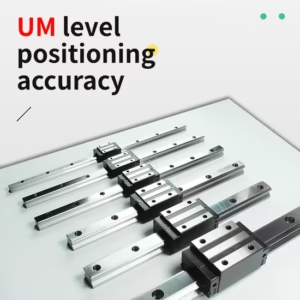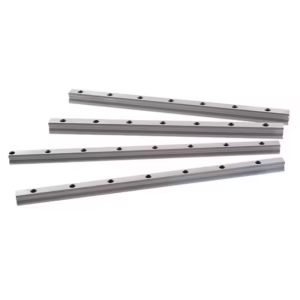Outline for “Linear Slide Rail”
| Main Heading | Sub-Headings |
|---|---|
| Introduction to Linear Slide Rail | Definition, Importance in Modern Industry |
| What is a Linear Slide Rail? | Concept, Basic Function |
| History and Evolution of Linear Slide Rails | From Sliding Guides to Precision Rails |
| Key Components of a Linear Slide Rail | Rails, Carriages, Rolling Elements, Seals |
| How Does a Linear Slide Rail Work? | Motion Principle, Load Transfer |
| Different Types of Linear Slide Rails | Ball Slide Rails, Roller Slide Rails, Needle Slide Rails, Plain Slide Rails |
| Ball Linear Slide Rail | Structure, Advantages, Applications |
| Roller Linear Slide Rail | Heavy Duty Applications, Rigidity |
| Needle Linear Slide Rail | Compact Systems, Space-Saving Benefits |
| Plain Linear Slide Rail | Simplicity, Low-Maintenance Options |
| Advantages of Linear Slide Rails | Accuracy, Efficiency, Long Service Life |
| Applications of Linear Slide Rails | Robotics, CNC Machines, Medical Devices, Automotive Industry |
| Linear Slide Rail in Robotics | High-Speed Precision, Automation Benefits |
| Linear Slide Rail in CNC Machines | Milling, Engraving, Cutting Applications |
| Linear Slide Rail in Medical Equipment | Imaging, Surgical Robots, Laboratory Devices |
| Choosing the Right Linear Slide Rail | Load Capacity, Precision Level, Environment |
| Factors Affecting Performance | Lubrication, Alignment, Material Choice |
| Installation of Linear Slide Rails | Tools Needed, Step-by-Step Setup |
| Maintenance of Linear Slide Rails | Lubrication, Cleaning, Inspections |
| Common Problems and Troubleshooting | Noise, Misalignment, Wear Issues |
| Future Trends in Linear Slide Rail Technology | Smart Rails, IoT Integration |
| Top Manufacturers of Linear Slide Rails | THK, NSK, HIWIN, SKF |
| Cost Analysis of Linear Slide Rails | Pricing Factors, Investment Value |
| Linear Slide Rail vs. Traditional Slide Systems | Performance, Efficiency, Durability |
| Linear Slide Rail | Recap of Importance and Future Growth |
| FAQs | Six Most Asked Questions |
| Conclusion | Final Thoughts |
Introduction to Linear Slide Rail
Linear slide rail systems are essential in precision engineering. They allow machinery and equipment to move with high accuracy, minimal friction, and consistent repeatability. From robotics to CNC machines, linear slide rails form the backbone of automation, ensuring that modern industries achieve speed, efficiency, and long-term reliability.
What is a Linear Slide Rail?
A linear slide rail is a mechanical system designed to guide motion in a straight line. Unlike rotary bearings that handle circular motion, slide rails ensure precise, straight movement. Typically, a slide rail consists of a rigid rail and a moving carriage or block fitted with rolling elements like balls or rollers, enabling smooth and friction-free travel.
History and Evolution of Linear Slide Rails
Early linear motion systems used sliding wooden or bronze surfaces lubricated with oil. These suffered from friction, heat, and wear. With the industrial revolution came steel rails, but they still required constant lubrication. The breakthrough occurred with rolling element technology in the 20th century, leading to today’s high-precision ball and roller slide rails. Modern versions now include advanced materials, surface treatments, and smart sensors for predictive monitoring.
Key Components of a Linear Slide Rail
Rail – The fixed guide along which motion occurs.
Carriage (Block) – The moving component that carries the load.
Rolling Elements – Balls, rollers, or needles that reduce friction.
Seals and Housing – Protection against dust, moisture, and debris.
How Does a Linear Slide Rail Work?
Linear slide rails work by rolling motion. The carriage moves along the rail with rolling elements between them. These rolling elements transfer the load evenly, reducing friction and wear compared to traditional sliding guides. This allows higher speeds, longer service life, and increased precision.
Different Types of Linear Slide Rails
There are several types of linear slide rails, each with unique advantages:
Ball Linear Slide Rails
Roller Linear Slide Rails
Needle Linear Slide Rails
Plain Linear Slide Rails
Ball Linear Slide Rail
Ball-type slide rails use recirculating steel balls. They are known for their smooth motion, low friction, and high precision. They are commonly used in CNC machining centers, robotics, and semiconductor manufacturing.
Roller Linear Slide Rail
Roller slide rails use cylindrical rollers instead of balls, providing higher rigidity and greater load capacity. They are ideal for heavy-duty equipment such as presses, injection molding machines, and industrial robots.
Needle Linear Slide Rail
Needle slide rails feature long, thin rollers. They offer a space-saving design and high load-bearing capacity for their size. These are widely used in compact automation devices and specialized laboratory machines.
Plain Linear Slide Rail
Plain slide rails rely on sliding contact rather than rolling elements. They are quieter, often maintenance-free, and excellent for applications requiring smooth, low-speed operation without vibration.
Advantages of Linear Slide Rails
High precision for repeatable tasks
Low friction and energy efficiency
Durability with long service life
High load capacity (especially roller types)
Smooth and stable motion
Applications of Linear Slide Rails
Linear slide rails are widely used in:
Robotics – For high-speed, accurate automation.
CNC Machines – For precision cutting and milling.
Medical Devices – For imaging and surgical robotics.
Automotive Industry – For testing systems and assembly automation.
Linear Slide Rail in Robotics
Robots rely on slide rails for precise and stable movement. They enable smooth travel, reducing vibration and ensuring accuracy in automated assembly and packaging.
Linear Slide Rail in CNC Machines
CNC machines demand repeatable precision. Linear slide rails ensure cutting tools move with exact accuracy, which results in high-quality finishes and efficient operations.
Linear Slide Rail in Medical Equipment
From CT scanners to robotic-assisted surgery, slide rails play a vital role. They allow smooth, controlled movements where precision is critical for patient safety.
Choosing the Right Linear Slide Rail
Consider the following factors:
Load requirements
Speed and acceleration needs
Environmental conditions (dust, moisture, temperature)
Accuracy and tolerance levels
Factors Affecting Performance
Proper lubrication is essential.
Alignment errors reduce precision.
Quality of materials impacts durability.
Environmental contamination accelerates wear.
Installation of Linear Slide Rails
Steps include:
Cleaning the mounting surface.
Aligning rails precisely.
Securing rails with bolts using proper torque.
Installing the carriage carefully.
Testing movement for smooth travel.
Maintenance of Linear Slide Rails
Regular lubrication with grease or oil.
Cleaning dust and debris.
Inspection for wear, cracks, or misalignment.
Replacing damaged seals promptly.
Common Problems and Troubleshooting
Noise during movement – Lack of lubrication.
Vibration or uneven travel – Misalignment.
Premature wear – Overloading or contamination.
Future Trends in Linear Slide Rail Technology
Integration of IoT sensors for predictive maintenance.
Use of advanced coatings for better wear resistance.
Development of lightweight alloys for efficiency.
Smart rails capable of real-time monitoring.
Top Manufacturers of Linear Slide Rails
THK (Japan)
NSK (Japan)
HIWIN (Taiwan)
SKF (Sweden)
These companies are industry leaders in innovation and quality.
Cost Analysis of Linear Slide Rails
Linear slide rail costs vary widely. Basic models start at around $40, while high-precision industrial versions can cost thousands. Investing in premium models ensures better performance and reduced long-term costs.
Linear Slide Rail vs. Traditional Slide Systems
| Feature | Linear Slide Rail | Traditional Slide System |
|---|---|---|
| Friction | Very low | High |
| Precision | High | Moderate |
| Load Capacity | Excellent | Limited |
| Maintenance | Needs lubrication | Low maintenance |
| Durability | Long-lasting | Shorter lifespan |
Linear Slide Rail
Linear slide rails have revolutionized motion technology by providing smooth, efficient, and accurate linear movement. They are indispensable in robotics, CNC machines, and medical technology. With future advancements, they will become even smarter and more reliable.
FAQs
What is a linear slide rail used for?
It is used to enable precise, smooth, and controlled linear motion in machinery.
Do linear slide rails need lubrication?
Yes, lubrication is vital for reducing friction and extending lifespan.
Which industries use linear slide rails most?
Robotics, CNC machining, automotive, and medical industries.
Can linear slide rails handle heavy loads?
Yes, roller-type slide rails are designed for heavy-duty applications.
How long do linear slide rails last?
With proper maintenance, they can last for several years in continuous use.
Are linear slide rails expensive?
Prices vary, but their long-term durability makes them a cost-effective investment.
Conclusion
Linear slide rails are vital for precision-driven industries. They provide smooth, accurate, and reliable motion in robotics, CNC machining, and medical equipment. As technology evolves, we can expect linear slide rails to integrate smart features, enhancing efficiency and reducing downtime, ensuring they remain essential in the world of advanced engineering.
Suggested Inbound Links:
Blog on CNC machining technologies
Article about robotics in industrial automation
Guide on industrial lubrication best practices




